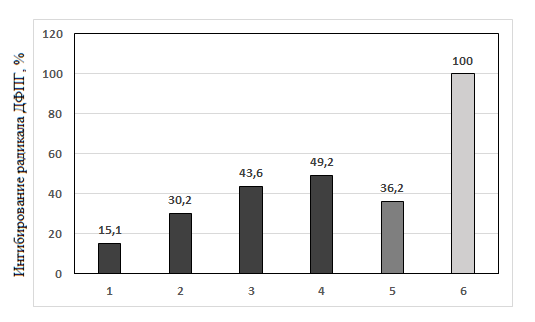ANTIMICROBIAL AND ANTIRADICAL ACTIVITY OF INDIVIDUAL FRACTIONS OF ESSENTIAL OIL FROM SEEDS OF HERACLEUM DISSECTUM LEDEB. OF SIBERIAN REGION
UDC 547.19
Abstract
By the method of exhaustive hydroponically obtained essential oil from beans of Heracleum dissectum Ledeb., growing in the Krasnoyarsk region. Separate fractions of oil were obtained: the first after 45 minutes from the beginning of distillation, the second – after 2 hours, the third-after 5 hours, the fourth fraction was collected after the end of hydro-distillation. The component composition of both whole essential oil and its separate fractions was studied. The main components are octyl acetate (60.0%), octyl-2-methylpropanoate (10.2%), n-hexyl-2-methylbutanoate (9.0%). The main amount of octyl acetate (64.7%) is concentrated in the first fraction of the oil. The antimicrobial activity of various fractions of essential oil of borscht dissected against strains of opportunistic microorganisms: Escherichia coli, Pseudomonas aeruginosa, Klebsiella pneumoniae, Staphylococcus aureus 209p, MRSA, Proteus vulgaris. It was found that, depending on the duration of isolation, the antimicrobial activity of essential oil fractions in relation to Staphylococcus aureus 209p, MRSA and Pseudomonas aeruginosa decreases, and in relation to Escherichia coli, Klebsiella pneumoniae and Proteus vulgaris increases. The most pronounced inhibitory effect of the third and fourth fractions of essential oil against Klebsiella pneumonia. The antiradical activity of all studied samples of borscht essential oil dissected in reaction with stable free 2,2-diphenyl-1-picrylhydrazyl radical was established. The first fraction showed minimal antiradical activity (15.1%), the fourth – maximum (49.2%).
Downloads
Metrics
References
Pimenov M.G., Ostroumova T.A. Zontichnyye (Umbelliferae) Rossii. [Umbrella (Umbelliferae) of Russia]. Moscow, 2012, 480 p. (in Russ.).
Makarov A.A. Lekarstvennyye rasteniya Yakutii i perspektivy ikh osvoyeniya. [Medicinal plants of Yakutia and the pro-spects for their development]. Novosibirsk, 2002, 264 p. (in Russ.).
Vinogradova Yu.K., Mayorov S.R., Khorun L.V. Chernaya kniga flory Sredney Rossii (Chuzherodnyye vidy rasteniy v ekosistemakh Sredney Rossii). [Black Book of Flora of Central Russia (Alien Plant Species in Ecosystems of Central Russia)]. Moscow, 2009, 494 p. (in Russ.).
Tkachenko K.G. Vestnik udmurtskogo universiteta, 2011, no. 1, pp. 88–100. (in Russ.).
Tkachenko K.G. Khimiya prirodnykh soyedineniy, 2010, no. 2, pp. 266–267. (in Russ.).
Tkachenko K.G. Khimiya prirodnykh soyedineniy, 2009, no. 4, pp. 487–489. (in Russ.).
Tkachenko K.G. Turczaninowia, 2010, vol. 13, no. 4, pp. 74–87. (in Russ.).
Kushakova A.C., Tkachenko K.G., Zenkevich I.G. Khimiya Rastitel'nogo Syr'ya, 2010, no. 4, pp. 111–114. (in Russ.).
Zykova I.D., Efremov A.A. Komponentnyy sostav efirnykh masel dikorastushchikh lekarstvennykh rasteniy flory Sibiri. [Component composition of essential oils of wild medicinal plants of Siberian flora]. Krasnoyarsk, 2014, 216 p. (in Russ.).
Tkachenko K.G., Platonov V.G., Satsyperova I.F. Rastitel'nyye resursy, 1995, vol. 31, no. 1, pp. 9–19. (in Russ.).
Tkachenko K.G. Journal of Herbs, Spices and Medicinal Plants, 2006, vol. 12, no. 3, pp. 1–12.
Zykova I.D., Efremov A.A., Naimushina L.V. Vestnik KrasGAU, 2017, no. 3, pp. 114–119. (in Russ.).
Khasanova S.R. Vestnik VGU. Seriya: Khimiya. Biologiya. Farmatsiya, 2007, no. 1, pp. 163–166. (in Russ.).
Tkachev A.V. Issledovaniye letuchikh veshchestv rasteniy. [Investigation of plant volatiles]. Novosibirsk, 2008, 969 p. (in Russ.).
Adams R.P. Identification of essential oil components by gas chromatography/mass spectrometry. 4th ed. Carol Stream: Allured Publ. Corp., 2007, 804 p.
Levi M.I., Gorozhankina I.A., Sagatovskaya L.A. Antibiotiki, 1967, no. 1, pp. 57–65. (in Russ.).
D'yakov S.I., Lebedeva I.K., Sidorenko S.V. Voyenno-meditsinskiy zhurnal, 1996, no. 3, pp. 44–47. (in Russ.).
Molyneux P. Songklanakarin J. Sci.Technol., 2004, vol. 26, no. 2, pp. 211–219.
Misharina T.A., Alinkina Ye.S., Fatkullina A.K., Vorob'yeva L.D., Medvedeva I.B., Burlakova Ye.B. Prikladnaya bio-khimiya i mikrobiologiya, 2012, vol. 48, no. 1, pp. 117–123. (in Russ.).
Alinkina Ye.S., Misharina T.A., Fatkullina A.K. Prikladnaya khimiya i mikrobiologiya, 2013, vol. 49, no. 1, pp. 82–87. DOI: 10.7868/S0555109913010029. (in Russ.).
Samusenko A.L. Khimiya Rastitel'nogo Syr'ya, 2012, no. 4, pp. 131–136. (in Russ.).

Copyright (c) 2020 сhemistry of plant raw material

This work is licensed under a Creative Commons Attribution 4.0 International License.

This work is licensed under a Creative Commons Attribution 4.0 International License.
The authors, which are published in this journal, agree to the following conditions:
1. Authors retain the copyright to the work and transfer to the journal the right of the first publication along with the work, at the same time licensing it under the terms of the Creative Commons Attribution License, which allows others to distribute this work with the obligatory indication of the authorship of this work and a link to the original publication in this journal .
2. The authors retain the right to enter into separate, additional contractual agreements for the non-exclusive distribution of the version of the work published by this journal (for example, to place it in the university depository or to publish it in a book), with reference to the original publication in this journal.
3. Authors are allowed to post their work on the Internet (for example, in a university repository or on their personal website) before and during the review process of this journal, as this may lead to a productive discussion, as well as more links to this published work.











